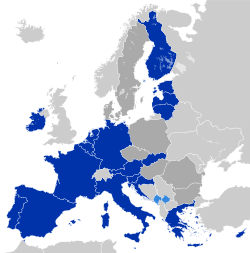 | |
 | |
| Policy of | |
|---|---|
| Policy area | Schengen Area |
| Type | Automated border control system |
| Start of implementation | 12 October 2025 |
| Complete implementation | 10 April 2026 |
| Applicable countries | |
| Replaces | Passport stamp |
| Administered by | eu-LISA |
| Website | Official website |
| This article is part of a series on |
 |
|---|
The Entry/Exit System (EES) is a system of the European Union for the automatic electronic monitoring and recording of border crossings of third-country nationals (non-EU/EFTA citizens) at all border crossings of the Schengen Area. The system, being operated by eu-LISA, is operational at some Schengen Area border checkpoints and will be operational at all Schengen Area border checkpoints by 10 April 2026, after which passport stamps will no longer be used upon entering or exiting the Schengen Area. [1] [2]
Contents
The system stores information including name, date of birth, fingerprints and biometrics for a facial recognition system, and locations and times of border crossings in a database of the European Travel Information and Authorisation System (ETIAS). [2]




